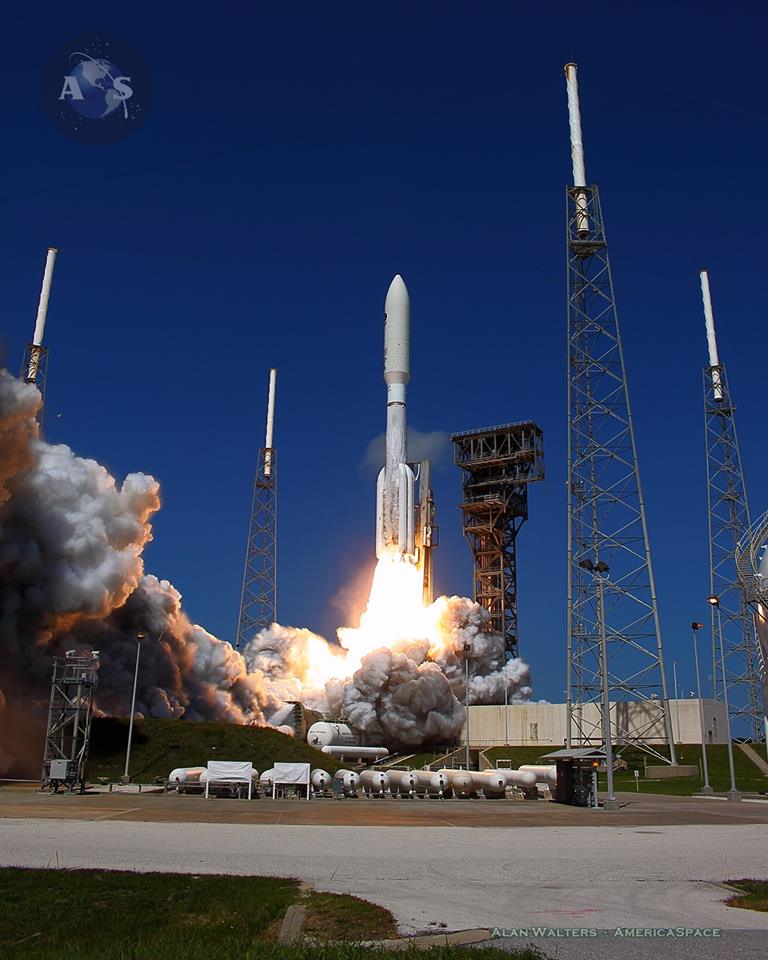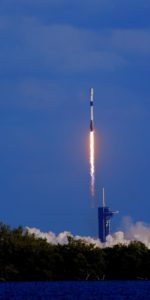
As United Launch Alliance (ULA) gears up for Monday’s scheduled launch its first Atlas V mission of the year—whose Launch Readiness Review (LRR) concluded yesterday—another payload targeted to fly next month has safely arrived on the Space Coast. The U.S. Space Force’s Space and Missile Systems Center (SMC) delivered their STPSat-6 space vehicle to the Astrotech Space Operations (ASO) in Titusville, Fla., last week, where it is now deep into pre-launch processing. It forms part of the multi-faceted Space Test Program (STP)-3 mission, whose ambitious remit includes operational nuclear detection functionality and demonstrating new technologies ranging from space-domain awareness to weather and advanced laser communications.
Current plans are for STPSat-6—primary payload for the STP-3 mission—to launch atop an Atlas V booster from storied Space Launch Complex (SLC)-41 at Cape Canaveral Space Force Station, Fla., no sooner than 23 June. Flying with a 17-foot-diameter (5-meter) payload fairing, five strap-on boosters and a single-engine Centaur upper stage, this will be the 12th launch of the “Mighty Atlas” in its most powerful (“551”) configuration. The 551 carries the potential to lift up to 41,500 pounds (18,800 kg) into low-Earth orbit and up to 19,600 pounds (8,900 kg) to geostationary altitude.
When fully stacked, the 551 stands 197 feet (60 meters) tall and is the ultimate heavylifter of the Atlas V fleet. It flew 11 times between January 2006 and March of last year. It first saw service to boost NASA’s New Horizons spacecraft to Pluto back in January 2006, after which it delivered the agency’s Juno orbiter to Jupiter in August 2011.

These scientific missions of exploration were followed by the launches of all five Mobile User Objective System (MUOS) narrowband military communications satellites between February 2012 and June 2016. More recently, a 551 lifted the Air Force Space Command’s AFSPC-11 mixed-manifest payload in April 2018 and the final three members of the Advanced Extremely High Frequency (AEHF) network in October 2018, August 2019 and March 2020. The 551’s most recent flight last spring marked the first major National Security Space Launch (NSSL) for the Space Force, just a few months after its inauguration.
The $191 million contract to launch STP-3 was signed between ULA and the Air Force way back in June 2017. It formed part of the Air Force’s Phase 1A procurement strategy, with initial expectations that the mission would fly within the June-August 2019 timeframe, although it has since met with significant delay. Postponed to late 2020, it eventually settled on a No Earlier Than (NET) February 2021 target launch date, before falling foul to additional delay.

STP-3 includes two primary payloads: STPSat-6 and the Space Force’s Long Duration Propulsion ESPA (LDPE)-1, both built by Northrop Grumman Corp. The LDPE-1 payload—reportedly now redesignated Rapid On-Orbit Space Technology and Evaluation Ring (ROOSTER)-1—is the first of a series of experimental spacecraft designed to accommodate small experiments and facilitate the deployment of small satellites.
Its design is based on Northrop Grumman’s ESPAStar platform, which utilizes a modified Evolved Expendable Launch Vehicle (EELV) Secondary Payload Adapter (ESPA) “ring” and supports a modular capability for hosting technology development and operational payloads. The ESPAStar concept provides power, pointing, telemetry and command-and-control functionality.

The LDPE-1/ROOSER-1 payload was delivered from Northrop Grumman’s Gilbert, Ariz., facility to Cape Canaveral Space Force Station in December 2020 and according to Col. Timothy Sehja, SMC’s Program Executive Officer for Space Development, marked a step closer “to advancing rideshare capabilities”.
However, STP-3’s scheduled 26 February launch ultimately proved untenable, following an announcement in January that STPSat-6 required additional “launch readiness” evaluations. Based upon Northrop Grumman’s A500 spacecraft bus, the geostationary-bound STPSat-6 houses nine payloads for the Department of Defense, the National Nuclear Security Administration (NNSA) and NASA to “operationally demonstrate advanced communication capabilities, collect space weather data and support nuclear detonation detection in the Earth’s atmosphere or in near space”.
Leading those payloads in the NNSA’s third Space and Atmospheric Burst Reporting System (SABRS)-3, built by Los Alamos National Laboratory (LANL) in Los Alamos, N.M., which is part of an ongoing effort to replace neutron, gamma-ray and particle detectors flown aboard Defense Support Program (DSP) satellites from the 1970s through the 1990s. It augments the optical, radio frequency, X-ray and particle sensors of the Global Burst Detector (GBD) payload aboard in-service Global Positioning System (GPS) satellites.
Also aboard STPSat-6 is the Laser Communication Relay Demonstration (LCRD), built by NASA’s Goddard Space Flight Center (GSFC) in Greenbelt, Md., which provides an end-to-end optical relay, capable of sending and receiving data from orbiting spacecraft to ground control stations. “This evolution to more internet-like communications will reduce the amount of processing required before data can be sent to science and mission operations centers,” NASA reported last year. “LCRD will demonstrate the robust capabilities of optical communications.” Specific benefits from optical communications systems include lower sizes, masses and power requirements and bandwidths 10-100 times greater than traditional radio frequency systems.

Several additional experiments from the Department of Defense’s Space Experiments Review Board are also assigned to fly aboard STPSat-6, reportedly “manifested after being assessed and prioritized by the DoD Space Experiment Review Board”. One of them is thought to be the NNSA’s Space and Endo-Atmospheric NuDet Surveillance Experiment (SENSER), which seeks to reduce the developmental risks for future Nuclear Detection sensors by testing and evaluating critical technologies in the space environment, ahead of production and integration into next-generation systems.
The postponement of the STP-3 mission due to STPSat-6 delays were reportedly in order “to enable the customer to evaluate the launch readiness of the spacecraft”, with few additional details provided. But on 6 May, the payload was finally transported from Northrop Grumman’s Dulles, Va., facility, to ASO in Titusville, to commence pre-flight processing. This will include launch site functional testing, fueling and integration with the LDPE-1/ROOSER-1 payload and stacking atop the Atlas V.

“The arrival of STPSat-6 at ASO is a huge success for the program,” said Col. Carlos Quinones, STP director. “The STPSat-6 team overcame many challenges to reach this milestone and have shown great resiliency and dedication. I couldn’t have asked for a better team to work with on this unique and challenging program.”
Scheduled to fly no sooner than 23 June, STP-3 will mark ULA’s third mission of the year, following on the heels of last month’s NROL-82 classified payload for the National Reconnaissance Office, out of Vandenberg Air Force Base, Calif., and the forthcoming Atlas V launch of the fifth geostationary element of the Space-Based Infrared System (SBIRS GEO-5) from Cape Canaveral Space Force Station. Stacking of the Mighty Atlas at SLC-41 was concluded earlier this month and on Thursday ULA teams completed the milestone Launch Readiness Review (LRR). Launch of SBIRS GEO-5 is currently targeted for 1:35 p.m. EDT Monday, 17 May.






go america and keep advancing we are not done yet great skill ula im proud to be an american